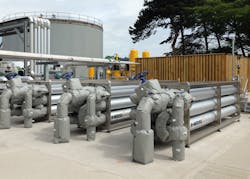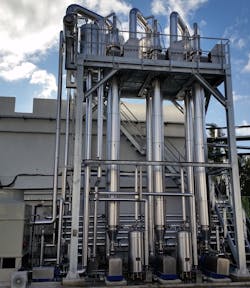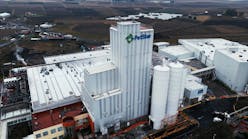Heat exchangers are widely used in wastewater treatment applications, particularly for general heating and evaporation applications. However, the challenging nature of wastewater and sludge such as its high viscosity and high fouling potential, means that it is important to choose the right type of heat exchanger to reduce costs, maximize energy efficiency, and maintain heat exchanger operational performance.
A range of scraped surface and corrugated tube heat exchangers can be specifically designed for sludge, digestate and wastewater applications. For example, HRS offers the double tube DTI and DTR Series through to the patented Unicus Series of reciprocating scraped surface heat exchangers. HRS also produces heat exchangers that can fit into existing and new wastewater installations and fully packaged systems for concentration, evaporation and pasteurization.
In contrast, the corrugated tubular design of the HRS DTI Series reduces fouling in a number of ways. The tube-in-tube design offers a much larger channel than spirals, thereby reducing blockages, while the corrugated inner tube encourages turbulence, increasing heat transfer and reducing fouling – the reason why HRS uses corrugated tubes. The tubes within the DTI Series are easy to clean and maintain. Removable bends make the tubes accessible, and there are no expensive gaskets to replace.
Another benefit of corrugated double-tube designs compared to SHEs is that the tubes can easily be removed for inspection, cleaning and maintenance. In many situations, a corrugated tube heat exchanger, like the HRS DTI Series, is the best solution for challenging materials such as sludge. However, in the most extreme cases with a very high fouling risk, it will be necessary to use a scraped-surface heat exchanger, such as either the HRS rotating R Series or the patented reciprocating Unicus Series.
The Unicus Series is based on traditional shell and tube heat exchangers, with the addition of a patented stainless steel scraping mechanism, which is hydraulically moved back and forth within each interior tube. This movement performs two key functions. First, it minimizes potential fouling of the product by keeping the tube wall clean. Second, the movement creates turbulence within the material. Both of these actions help to increase heat transfer rates, and together, they create a highly efficient heat transfer process ideal for viscous and high fouling materials.
The HRS Unicus series has proven particularly useful in handling challenging materials that have a high fouling potential, such as digestate produced by biogas production. The Unicus means that effective heat transfer can be carried by preventing the buildup of fouling layers.
The prevention of fouling can be particularly important for evaporation applications, so HRS Heat Exchangers have developed a special version of the Unicus for evaporation systems where volume reduction is vital. The scraping action keeps the heat transfer surfaces clean, meaning that Unicus evaporators can concentrate materials to a level beyond that typically achieved with traditional technologies. The Unicus evaporators can be used in either multi-effect design or in combination with mechanical vapor recompression.
Whatever wastewater treatment is required, from heating grey water through to evaporating thick sludges, choosing an appropriate solution can help maximize energy efficiency and maintain heat exchanger operational performance.
About the author: Cameron Creech is general manager with HRS Heat Exchangers. HRS Heat Exchangers is part of the HRS Group, which operates at the forefront of thermal technology, offering innovative heat transfer solutions worldwide across a diverse range of industries.





